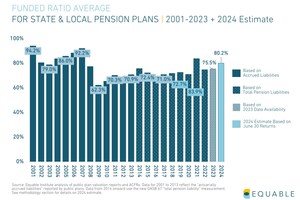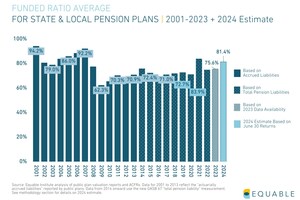NEW YORK, June 29, 2021 /PRNewswire/ -- A new report from Equable Institute measuring the adequacy of state retirement benefits for public sector workers found that only three statewide public retirement plans serve all employees well regardless of career tenure – South Carolina Retirement System's Optional Retirement Plan, Texas CDRS's High Credit Plans, and Tennessee Retirement System's Hybrid Plan. The report also finds that Florida, New Jersey, and Louisiana offer the worst plans for all workers when evaluated based on retirement income adequacy.
The First Edition of "The National Landscape of State Retirement Benefits" is a topline analysis of the data included in recently released Retirement Security Report – an interactive, digital evaluation of the quality of retirement benefits offered to public workers nationwide using customizable score cards for all 335 statewide retirement plans currently open to new hires. The project is focused on determining whether individual plans are providing public workers with a path to retirement income security, showing how well plans work depending on career tenure and age.
"It is clear after reviewing this wealth of data from the Retirement Security Report that most public sector retirement plans are only designed to work for those who work a full career in public service," said Anthony Randazzo, co-author of the report and Equable Institute Executive Director. "For those who will put in three to four decades of public service in the same state, this should be an encouragement. But this should be disappointing and disconcerting for the majority of public workers — particularly the short-term and medium-term workers who provide up to 20 years of public service. We should expect that state retirement plans are designed so that all workers have a path to retirement income adequacy."
Each retirement plan included in the Retirement Security Report has unique benefits scores for short-term workers, medium-term workers and full career workers based on entry into their plans at the age of 25 and 40. The aggregate scores for each plan reveal the best and worst plans for putting employees on a path to retirement income security.
The Best Statewide Public Retirement Plans for Income Security
Plan Type |
Benefits Score |
||
1. |
South Carolina RS DC Plan General |
DC Plan |
98.4% |
2. |
South Carolina RS DC Plan Teachers |
DC Plan |
95.2% |
T3. |
Texas CDRS General High Credit |
GR Plan |
93.4% |
T3. |
Texas CDRS Police & Fire High Credit |
GR Plan |
93.4% |
5. |
Tennessee TRP Hybrid Plan |
Hybrid |
88.4% |
6. |
Montana PERS DC Plan |
DC Plan |
87.8% |
7. |
Michigan SERS DC Plan |
DC Plan |
84.6% |
8. |
Oregon OPSRP Police & Fire |
Hybrid |
83.9% |
9. |
South Dakota RS Generational Plan Public Safety |
Hybrid |
83.5% |
10. |
Washington LEOFF Plan 2 |
Pension |
81.9% |
The Worst Statewide Public Retirement Plans for Income Security
Plan Type |
Benefits Score |
||
326. |
Louisiana TRSL Lunch Plan A |
Pension |
37.0% |
327. |
Florida RS Pension Regular Class K-12 Teachers |
Pension |
35.6% |
328. |
Florida RS Pension Regular Class Non-K-12 |
Pension |
35.6% |
329. |
Florida RS Pension Senior Management Class |
Pension |
35.5% |
330. |
Louisiana LASERS Regular |
Pension |
33.7% |
331. |
Louisiana TRSL Teachers |
Pension |
33.1% |
332. |
Louisiana Municipal Police |
Pension |
30.5% |
333. |
Louisiana TRSL Higher-Ed |
Pension |
28.4% |
334. |
Louisiana TRSL Lunch Plan B |
Pension |
27.1% |
335. |
New Jersey State Police RS Tier 2 |
Pension |
21.1% |
For the full list of rankings, please visit www.equable.org/retirementplanrankings.
"Any kind of retirement plan can be built to provide a path to adequate retirement security for all members. And conversely any kind of plan design can be poorly developed and inadequately designed," says Equable's vice president for research, and report co-author Dr. Jonathan Moody. "Pension plans are typically designed to provide most of their benefits to those who work more than two decades, so they tend to perform best for full career workers. But even for those with 15, 16, and 17 years of service pension plans can sometimes be inadequate."
Randazzo notes, "In retirement plan debates, it is commonplace to compare the value of one type of retirement plan against another and argue over which offers the most benefits at retirement. But a better way to think about retirement plans is to measure them against a common benchmark for adequate retirement income. Looked at this way, there are good and bad ways to design every kind of retirement plan, whether pension, defined contribution, guaranteed return, or hybrid."
The summary report also includes topline rankings by plan type and worker tenure, as well as analysis based on profession. To dive deeper into the findings of the Retirement Security Report, visit www.RetirementSecurity.Report to explore individual plans' scores, download the summary report and access Equable Institute's open-source data.
About Equable Institute
Equable is a bipartisan non-profit that works with public retirement system stakeholders to solve complex pension funding challenges with data-driven solutions. We exist to support public sector workers in understanding how their retirement systems can be improved, and to help state and local governments find ways to both fix threats to municipal finance stability and ensure the retirement security of all public servants.
Equable.org | Twitter: @EquableInst | Facebook: @EquableInstitute | Instagram: @EquableInst
SOURCE Equable Institute

Related Links
WANT YOUR COMPANY'S NEWS FEATURED ON PRNEWSWIRE.COM?
Newsrooms &
Influencers
Digital Media
Outlets
Journalists
Opted In






Share this article